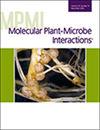Po-Yuan Shih, Stéphanie Le Bras, Rémi Ollivier, Hélène Boulain, Stéphanie Morlière, Yannick Outreman, Jean-Christophe Simon, Akiko Sugio
求助PDF
{"title":"豌豆蚜虫的一种唾液效应物与豌豆蛋白相互作用并提高其在寄主植物上的性能。","authors":"Po-Yuan Shih, Stéphanie Le Bras, Rémi Ollivier, Hélène Boulain, Stéphanie Morlière, Yannick Outreman, Jean-Christophe Simon, Akiko Sugio","doi":"10.1094/MPMI-08-24-0089-R","DOIUrl":null,"url":null,"abstract":"<p><p>Aphids have intricate interactions with their host plants, but the molecular mechanisms behind these interactions remain largely unknown. The pea aphid, <i>Acyrthosiphon pisum</i>, is a legume specialist that forms a complex of several biotypes, each specialized in feeding on a few legume species. Aphids inject a cocktail of salivary effector proteins into plants to suppress plant immunity and promote their performance, such as fecundity. Previous studies showed that subsets of salivary effector genes of <i>A. pisum</i> are differentially expressed between the pea- and alfalfa-adapted biotypes. We hypothesized that the salivary effector genes that are important for <i>A. pisum</i> to feed on pea (<i>Pisum sativum</i>) are highly expressed in the pea-adapted biotype compared with non-adapted ones and selected such genes for functional characterization. We examined 10 candidate genes and found that expression of the salivary gene <i>LOC100159932</i> (<i>Ap4</i>) in pea leaves increased the fecundity of the <i>A. pisum</i> pea biotype. A yeast two-hybrid screening using Ap4 as a bait identified two pea proteins named PsBPL1 and PsBPL2 that showed high homology with Arabidopsis BPL (Binding Partner of ACD11-Like) proteins, which are conserved in plants and fungi and known to be involved in plant immunity. GFP-tagged Ap4 proteins produced puncta in <i>Nicotiana benthamiana</i> cytoplasm, and a bimolecular fluorescence complementation experiment confirmed the interaction of Ap4 and PsBPL1 and PSBPL2 in planta. These results highlight Ap4's role as an effector and suggest the involvement of BPL proteins in pea-aphid interactions. [Formula: see text] Copyright © 2025 The Author(s). This is an open access article distributed under the CC BY 4.0 International license.</p>","PeriodicalId":19009,"journal":{"name":"Molecular Plant-microbe Interactions","volume":" ","pages":"MPMI08240089R"},"PeriodicalIF":3.4000,"publicationDate":"2025-09-18","publicationTypes":"Journal Article","fieldsOfStudy":null,"isOpenAccess":false,"openAccessPdf":"","citationCount":"0","resultStr":"{\"title\":\"A Salivary Effector of the Pea Aphid Interacts with Pea Proteins and Enhances Its Performance on the Host Plant.\",\"authors\":\"Po-Yuan Shih, Stéphanie Le Bras, Rémi Ollivier, Hélène Boulain, Stéphanie Morlière, Yannick Outreman, Jean-Christophe Simon, Akiko Sugio\",\"doi\":\"10.1094/MPMI-08-24-0089-R\",\"DOIUrl\":null,\"url\":null,\"abstract\":\"<p><p>Aphids have intricate interactions with their host plants, but the molecular mechanisms behind these interactions remain largely unknown. The pea aphid, <i>Acyrthosiphon pisum</i>, is a legume specialist that forms a complex of several biotypes, each specialized in feeding on a few legume species. Aphids inject a cocktail of salivary effector proteins into plants to suppress plant immunity and promote their performance, such as fecundity. Previous studies showed that subsets of salivary effector genes of <i>A. pisum</i> are differentially expressed between the pea- and alfalfa-adapted biotypes. We hypothesized that the salivary effector genes that are important for <i>A. pisum</i> to feed on pea (<i>Pisum sativum</i>) are highly expressed in the pea-adapted biotype compared with non-adapted ones and selected such genes for functional characterization. We examined 10 candidate genes and found that expression of the salivary gene <i>LOC100159932</i> (<i>Ap4</i>) in pea leaves increased the fecundity of the <i>A. pisum</i> pea biotype. A yeast two-hybrid screening using Ap4 as a bait identified two pea proteins named PsBPL1 and PsBPL2 that showed high homology with Arabidopsis BPL (Binding Partner of ACD11-Like) proteins, which are conserved in plants and fungi and known to be involved in plant immunity. GFP-tagged Ap4 proteins produced puncta in <i>Nicotiana benthamiana</i> cytoplasm, and a bimolecular fluorescence complementation experiment confirmed the interaction of Ap4 and PsBPL1 and PSBPL2 in planta. These results highlight Ap4's role as an effector and suggest the involvement of BPL proteins in pea-aphid interactions. [Formula: see text] Copyright © 2025 The Author(s). This is an open access article distributed under the CC BY 4.0 International license.</p>\",\"PeriodicalId\":19009,\"journal\":{\"name\":\"Molecular Plant-microbe Interactions\",\"volume\":\" \",\"pages\":\"MPMI08240089R\"},\"PeriodicalIF\":3.4000,\"publicationDate\":\"2025-09-18\",\"publicationTypes\":\"Journal Article\",\"fieldsOfStudy\":null,\"isOpenAccess\":false,\"openAccessPdf\":\"\",\"citationCount\":\"0\",\"resultStr\":null,\"platform\":\"Semanticscholar\",\"paperid\":null,\"PeriodicalName\":\"Molecular Plant-microbe Interactions\",\"FirstCategoryId\":\"99\",\"ListUrlMain\":\"https://doi.org/10.1094/MPMI-08-24-0089-R\",\"RegionNum\":3,\"RegionCategory\":\"生物学\",\"ArticlePicture\":[],\"TitleCN\":null,\"AbstractTextCN\":null,\"PMCID\":null,\"EPubDate\":\"\",\"PubModel\":\"\",\"JCR\":\"Q2\",\"JCRName\":\"BIOCHEMISTRY & MOLECULAR BIOLOGY\",\"Score\":null,\"Total\":0}","platform":"Semanticscholar","paperid":null,"PeriodicalName":"Molecular Plant-microbe Interactions","FirstCategoryId":"99","ListUrlMain":"https://doi.org/10.1094/MPMI-08-24-0089-R","RegionNum":3,"RegionCategory":"生物学","ArticlePicture":[],"TitleCN":null,"AbstractTextCN":null,"PMCID":null,"EPubDate":"","PubModel":"","JCR":"Q2","JCRName":"BIOCHEMISTRY & MOLECULAR BIOLOGY","Score":null,"Total":0}
引用次数: 0
引用
批量引用

 求助内容:
求助内容: 应助结果提醒方式:
应助结果提醒方式:


